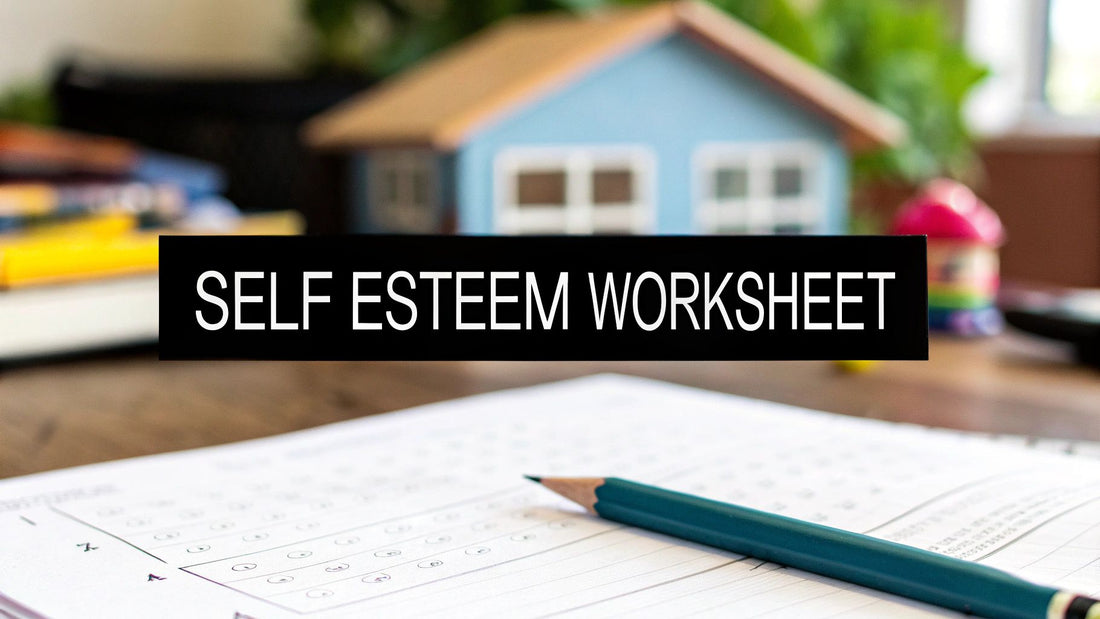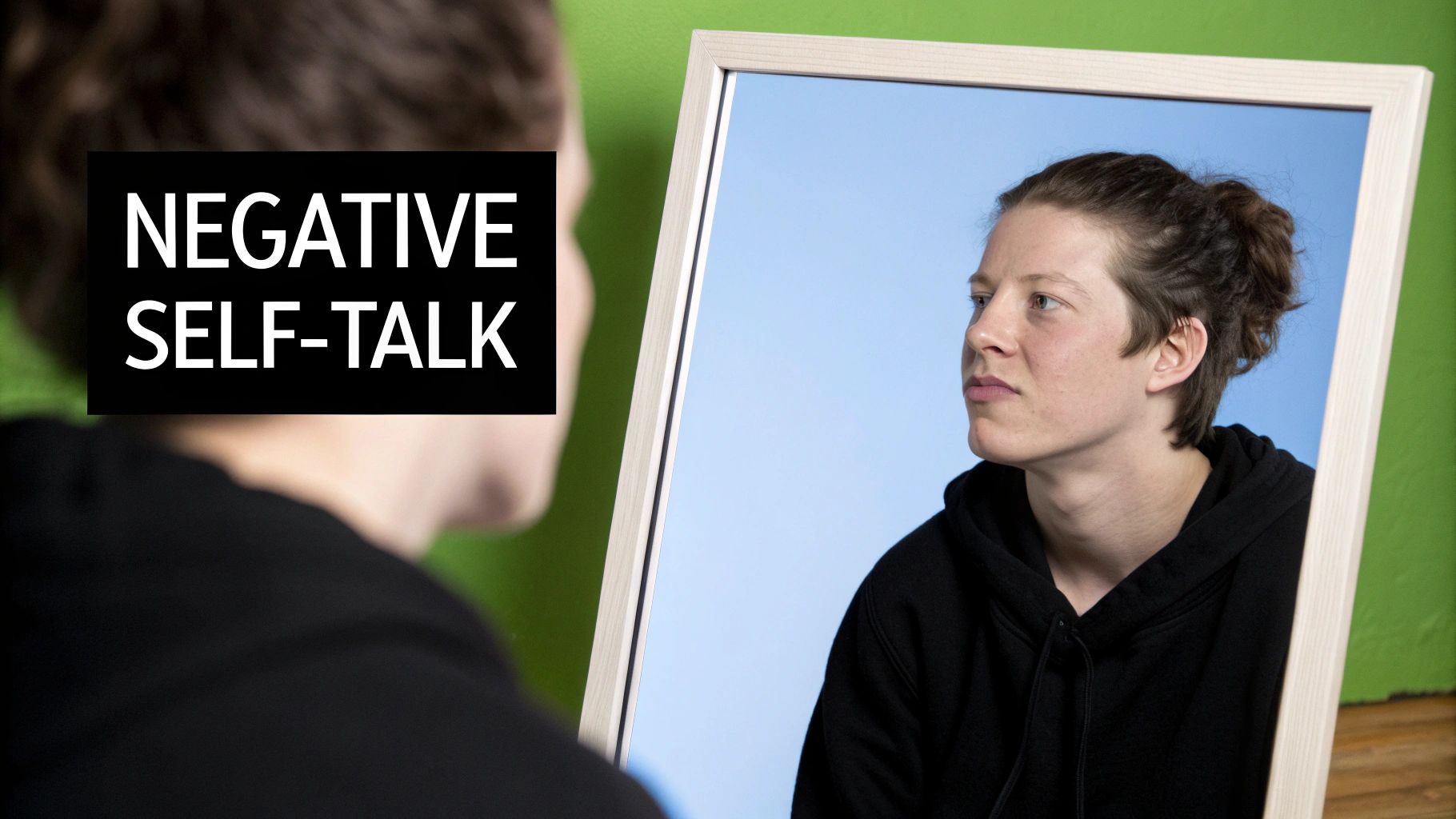
A Guide to Using a Self Esteem Worksheet
Share
So, what exactly is a self esteem worksheet?
Think of it less like homework and more like a gentle, guided conversation on paper. It's an activity designed to help young people explore their feelings, recognise their unique strengths, and start building a more positive way of seeing themselves. Essentially, it's a safe space to nurture self-worth.
The Importance of Building Youth Self Esteem
Self-esteem is so much more than just feeling good about yourself; it’s the very foundation of resilience. It acts as an inner anchor, helping children and teenagers navigate the inevitable storms of growing up, from friendship troubles to the pressures of school.
When a young person has a healthy sense of self-worth, they're simply better equipped to handle setbacks. They can make sounder decisions and have the confidence to go after their goals.
Sadly, the state of youth mental health in the UK shows a real and pressing need for support. One in five children now have a probable mental health disorder, a significant rise in recent years. Challenges with self-esteem are particularly widespread among adolescents, with some research suggesting that between one-third to one-half of all teenagers experience low self-esteem.
The COVID-19 pandemic only made things tougher. Confidence and happiness levels among 16 to 25-year-olds in the UK plummeted to a 13-year low. You can discover more about these teen self-esteem statistics and their impact to get the full picture.
Why Early Intervention Matters
Tackling low self-esteem early isn't just a nice idea; it's absolutely essential. It is a crucial part of preventative mental health care. Low self-worth in childhood can create ripples that last well into adulthood, affecting everything from career choices to personal relationships.
And then there's the pressure of social media, where curated perfection is everywhere. It’s incredibly difficult for young people to see their own value when they’re constantly faced with a distorted version of reality. A recent report found that nearly a third of UK teenagers feel social media has a negative impact on their self-esteem. This culture of comparison can magnify even the smallest insecurities.
Important Disclaimer: I am not a mental health professional. While a self esteem worksheet is a wonderful tool for starting conversations and building positive habits, it is not a substitute for professional medical advice. If you have serious concerns about a child's mental health, please consult a GP or a qualified mental health professional.
By introducing simple, practical tools like these worksheets, we can give families and educators a gentle starting point. These resources help normalise talking about feelings and empower young people with the skills to build a strong, positive internal voice that will support them for the rest of their lives.
How A Self-Esteem Worksheet Builds Confidence
It might seem like a simple piece of paper, but a self-esteem worksheet can spark some truly meaningful change. Think of it as a guided workout for the mind, designed to strengthen the ‘muscle’ of self-worth through small, consistent exercises. It’s not about finding a magic fix; it’s all about the practice.

These worksheets take powerful psychological ideas and make them easy to grasp. One of the core techniques they use is cognitive reframing—which is really just a way of learning to spot negative thoughts and then challenge or change them. Another is gratitude, which helps to gently shift focus from what's going wrong to what's going right.
By working through prompts that highlight their personal strengths and past wins, a young person starts to build a more balanced and realistic picture of who they are. These small, repeated actions help forge stronger, more positive pathways in the brain. For more ideas, you can explore other powerful self-esteem building exercises that work beautifully alongside worksheets.
Building Positive Foundations
The real power of a self-esteem worksheet is in its structure. It provides a simple framework for self-reflection, which can feel really overwhelming when you don't know where to start.
Here’s how some of the activities help build that inner confidence:
- Strength Spotting: By writing down things they do well—anything from being a kind friend to solving a tricky puzzle—a young person creates real, tangible evidence of their capabilities. For example, a prompt might be, "Name a time you helped someone this week."
- Achievement Logs: Listing past successes, no matter how small they seem, is a powerful reminder of their resilience and ability to get through tough times. This could be as simple as, "I finished my homework even when I found it hard."
- Gratitude Prompts: Focusing on what they are thankful for helps to counteract the brain's natural habit of dwelling on the negative stuff. A practical example is, "Write down three things that made you smile today."
Each prompt they complete is like laying another brick, gradually building a solid foundation of self-worth. Over time, this makes it so much easier to handle social pressures and quieten that inner critic.
For a deeper dive into developing a strong sense of self, have a look at these proven strategies to boost self-esteem and confidence. Worksheets give you the focused practice, while broader strategies help weave these new skills into everyday life, creating positive change that truly lasts.
Using Worksheets to Nurture Self Esteem at Home
Bringing a self-esteem worksheet into your home shouldn't feel like another piece of homework. The goal is to create a positive, shared space where your child feels completely safe to explore their thoughts and feelings, free from any pressure or judgement.
Timing really is everything. Try to pick a calm moment, maybe on a quiet weekend afternoon when you can sit down together without feeling rushed. A great way to lead is by filling out your own answers alongside them. This models openness and shows that everyone, even grown-ups, has to work on their sense of self-worth.
Turning Worksheets Into Conversation Starters
The real magic of these exercises happens in the conversations they spark. Think of the prompts on the worksheet as just the beginning.
Use them as a gentle springboard to ask open-ended questions and, most importantly, really listen to their answers. This transforms a simple activity into a powerful moment of connection, reinforcing the message that their feelings are valid and important. For more ideas, you can also explore these brilliant kids' mental health activities which are a great complement to worksheet sessions.
This infographic helps to visualise the core purpose of a self esteem worksheet which is helping individuals identify their inherent strengths.

This image symbolises how focusing on our strengths allows us to feel empowered and grounded in our own value.
Building Resilience Against Online Pressures
In an age so dominated by social media, a child's self-esteem is constantly under fire. The curated perfection they see online creates an impossible standard to live up to, often leading to deep feelings of inadequacy. Poor mental health now costs UK businesses an estimated £56 billion each year in lost productivity, and these early pressures can cast a very long shadow.
A self-esteem worksheet is a powerful offline tool. It helps children build an internal defence against these external pressures by grounding their self-worth in their own character, achievements, and unique qualities—not in likes or follower counts.
By helping them focus on what makes them special away from the screen, you’re giving them the tools to build a resilient sense of self. This is a crucial step in nurturing their overall wellbeing and helping them stand strong against the challenges of the online world.
The Hidden Costs of Low Self Esteem in Society
The impact of low self-esteem doesn't just stay with one person; it sends ripples out across communities and even the national economy. When struggles with self-worth begin in childhood and aren't addressed, they almost always follow us into adult life, shaping how we show up at work and affecting overall productivity.

Here in the UK, the cost of poor mental health to businesses is staggering. Problems that have their roots in low self-esteem can lead to higher rates of presenteeism (where people are at work but not really working) and absenteeism, both of which hit a company's bottom line. Think about it: an employee wrestling with self-doubt might hold back a brilliant idea or shy away from a leadership role, stunting their own growth and the organisation's potential.
A Broader Societal View
A quick look at the mental health landscape in Great Britain shows just how common these challenges are. The latest data reveals that 18% of adults are dealing with moderate to severe depressive symptoms. That figure jumps to a worrying 26% for young people aged 16 to 29. On top of that, with 72% of adults feeling the pinch from the rising cost of living, financial stress can crush a person's sense of self-worth, spinning up a nasty cycle of anxiety. You can dig deeper into these public opinion and social trends on ONS.gov.uk.
This is precisely why getting in early with tools like a self esteem worksheet is so incredibly important. It's not just about making one child feel a bit better; it's a preventative step towards building a healthier, more resilient society for the future.
By normalising conversations around mental wellbeing from a young age, we equip the next generation with the emotional tools they need to become confident and productive members of the community.
Investing in these foundational skills helps ease the long-term strain on our health services and nurtures a more supportive and prosperous society for all of us. Simple worksheets might seem small, but they play a vital part in this much larger picture.
Resources to Support the Confidence Journey
A single worksheet is a fantastic starting point, but building lasting confidence is more of a journey than a one-off task. The best way to support this growth is to weave small, positive habits into daily life. Think of it like putting together a complete toolkit for mental wellbeing, where every resource has a different but equally important job to do.
Beyond worksheets, reading books together can be a wonderful way to explore ideas around self-worth. For younger children, titles like The Koala Who Could by Rachel Bright can open up conversations about bravery, while for older readers, books like The Perks of Being a Wallflower by Stephen Chbosky explore themes of identity and belonging. If you're looking for a wider perspective, you can explore a comprehensive guide to building self-esteem in children, which is packed with other helpful strategies.
Practical Tools for Daily Reinforcement
Sometimes, the simplest, most tangible reminders can make the biggest difference. Here are a few practical relaxation tips to try:
- Box Breathing: Breathe in for a count of four, hold for four, breathe out for four, and hold for four. Repeat a few times to calm the nervous system.
- Mindful Listening: Sit quietly for one minute and try to identify every single sound you can hear, both near and far. This anchors you in the present moment.
- A 'Happy Place' Visualisation: Close your eyes and imagine a safe, peaceful place in detail. Focus on what you can see, hear, and feel there.
Even the clothes we wear can act as a little prompt for positivity. There are several UK-based mental health apparel brands that create clothing with uplifting affirmations, serving as a wearable reminder of personal strength and resilience as you go about your day. For parents after more focused support, exploring different mental health resources for teens can offer targeted guidance and fresh ideas.
Building self-esteem is an ongoing journey, not a destination. The goal is to collect a variety of tools that can provide comfort and strength whenever they are needed most.
By combining worksheets with books, conversations, and daily positive practices, you create a rich and nurturing environment where a child's confidence can truly flourish.
A Few Common Questions About Self-Esteem
To help you feel completely confident moving forward, let's walk through some of the most common questions people have about using a self-esteem worksheet. My goal is to give you clear, practical answers so you can start this positive journey with your child, pupils, or even for yourself.
What Age Is Best to Introduce These Worksheets?
Honestly, there’s no strict rule. It’s all about matching the activity to the child's developmental stage. You can begin with simple, drawing-based ideas around age five or six, using prompts like, ‘Draw something that makes you feel proud.’
For primary school children (ages 7-12), worksheets with guided prompts about their strengths and achievements tend to work brilliantly. Teenagers often get more from complex exercises that explore personal values, challenge negative self-talk, and help them focus on future goals.
How Often Should We Use a Self-Esteem Worksheet?
When it comes to building self-esteem, consistency is so much more important than intensity. Aim for one or two short, positive sessions per week. This helps build a healthy habit without it ever feeling like a chore.
Making it a relaxed Sunday afternoon ritual can be a great way to reflect on the week's wins together. If you notice any resistance, it’s perfectly fine to take a break and try a different approach later on.
What Should I Do If My Child Gives Negative Answers?
This is a really normal—and valuable—moment for connection. The most important thing is to avoid the urge to immediately correct them or push for a more ‘positive’ answer.
Instead, validate their feelings with gentle phrases like, ‘It sounds like that was really tough. It’s okay to feel that way sometimes.’ You can then gently offer your own observations, such as, ‘I saw how kindly you shared your snacks today, and I thought that was a real strength.’ The goal is always to create a safe space for complete honesty without any judgement.
Important Disclaimer: Please remember, I am not a mental health professional. These worksheets are a supportive tool, not a clinical treatment.
It is always time to contact your GP or a mental health professional if you are worried. Seek professional help if you observe persistent signs of distress in a child, such as significant changes in sleep or appetite, social withdrawal, loss of interest in activities they once loved, or any talk of hopelessness or self-harm. Always trust your instincts and seek professional guidance when you feel things are beyond your scope.
At Little Fish Books, we believe in nurturing emotional wellbeing from a young age. Explore our range of books, activities, and resources designed to support children and young people on their confidence journey. Visit us at https://thatsokay.co.uk to learn more.
